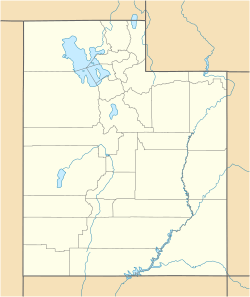Grass Creek, Utah facts for kids
Quick facts for kids
Grass Creek
|
|
|---|---|
| Country | United States |
| State | Utah |
| County | Summit |
| Established | 1860 |
| Abandoned | 1940 |
| Elevation | 6,348 ft (1,935 m) |
| GNIS feature ID | 1428345 |
Grass Creek is a ghost town located in Summit County, Utah, United States. It's about 8 miles (13 km) northeast of Coalville. Grass Creek was once a very important town for coal mining. People lived there from around 1860 to 1940.
Contents
The Story of Grass Creek: A Coal Mining Town
How Grass Creek Started
In 1859, coal was found near the Weber River. This led to the creation of the town of Coalville. The next year, in 1860, Brigham Young sent people to look for more coal. They found thick layers of coal just north of Coalville, in Grass Valley Canyon.
Soon after, The Church of Jesus Christ of Latter-day Saints opened a coal mine in the canyon. A few families of miners built homes near the mine. They called their new settlement Grass Creek.
Growing with the Silver Boom
In the 1870s, there was a big rush to mine silver in the Park City area. This meant there was a sudden need for lots of coal. People who were not Mormons quickly invested money to develop the mines in Grass Valley Canyon.
The Grass Creek Fuel Company built its own company town at Grass Creek. They built homes on the north side of the canyon. The main business area was on the south side. As more people moved in, Grass Creek added many buildings. These ranged from simple miners' shacks to fancy stone homes for the mine owners. There was even a special area called a Chinatown.
Coal Transport and Railroads
Until 1873, coal was pulled by ox teams all the way to Salt Lake City. This was a long and slow journey. In 1873, a narrow gauge railway was built. It was called the Summit County Railroad. This railway connected Echo to Coalville and then to Grass Creek.
Even though the Union Pacific Railroad charged high fees, using the train was much better. It was a more efficient way to ship the coal. Then, in 1881, the Union Pacific built its own standard gauge railway. This new line, called the Echo and Park City Railroad, ran next to the Summit County Railroad.
The part of the railway from Coalville to Grass Creek became a special "dual gauge" track. This meant it had three rails. It could carry trains of both narrow and standard sizes. The Union Pacific even ran its own coal mine in Grass Creek from 1880 to 1887.
Many people in Grass Creek worried about the Union Pacific Railroad. They saw the company as a powerful monopoly that could control everything. Grass Creek depended completely on its coal mines. This meant the town was at the mercy of the railroad. People often believed that the Union Pacific purposely raised shipping costs. They also thought the railroad limited how many coal cars left Coalville. This was supposedly to help the company's own coal mines in Rock Springs, Wyoming.
Peak Years and New Owners
Even with its risky dependence on one industry, Grass Creek continued to grow. The busiest time in the canyon was from about 1881 to 1910. By 1904, the town had a school and a post office. In 1907, a rich businessman from Ogden named David Eccles bought over 1,000 acres (4.0 km²) of coal fields. He started the Union Fuel Company.
In the 1910 United States Census, Grass Creek had 190 people. After that, the population started to drop.
Why Grass Creek Disappeared
The coal in Grass Creek was found in soft clay. This caused the mines to fill with water. It also led to dangerous cave-ins. Because of the high cost and risks, it was hard for Grass Creek to compete. Other mines were safer and produced better quality coal.
By 1921, only two mines were still working. But they were still producing about 200 short tons (181 tonnes) of coal each day. By 1931, the only customer for Grass Creek coal was a cement plant in Croydon. That year, the cement plant closed down. In 1932, the Union Pacific Railroad asked for permission to stop using the railway line to Grass Creek.
The coal mines kept going for a few more years. This happened because the cement plant got a contract to supply materials for building Boulder Dam. However, by 1940, the Grass Creek mines and the railroad were permanently closed.
Today, all of Grass Valley Canyon is privately owned. It is not open to the public.



